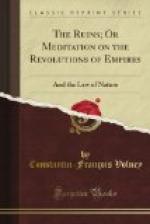“Moses, who was one of the Egyptian priests, taught his followers that it was an egregious error to represent the Deity under the form of animals, as the Egyptians did, or in the shape of man, as was the practice of the Greeks and Africans. That alone is the Deity, said he, which constitutes heaven, earth, and every living thing; that which we call the world, the sum of all things, nature; and no reasonable person will think of representing such a being by the image of any one of the objects around us. It is for this reason, that, rejecting every species of images or idols, Moses wished the Deity to be worshipped without emblems, and according to his proper nature; and he accordingly ordered a temple worthy of him to be erected, etc. Geograph. lib. 16, p. 1104, edition of 1707.
The theology of Moses has, then, differed in no respect from that of his followers, that is to say, from that of the Stoics and Epicureans, who consider the Deity as the soul of the world. This philosophy appears to have taken birth, or to have been disseminated when Abraham came into Egypt (200 years before Moses), since he quitted his system of idols for that of the god Yahouh; so that we may place its promulgation about the seventeenth or eighteenth century before Christ; which corresponds with what we have said before.
As to the history of Moses, Diodorus properly represents it when he says, lib. 34 and 40, “That the Jews were driven out of Egypt at a time of dearth, when the country was full of foreigners, and that Moses, a man of extraordinary prudence seized this opportunity of establishing his religion in the mountains of Judea.” It will seem paradoxical to assert, that the 600,000 armed men whom he conducted thither ought to be reduced to 6,000; but I can confirm the assertion by so many proofs drawn from the books themselves, that it will be necessary to correct an error which appears to have arisen from the mistake of the transcribers.
*** This was the monosyllable
written on the gates of the
temple of Delphos.
Plutarch has made it the subject of a
dissertation.
**** These are the literal expressions of the book of Deuteronomy, chap. XXXII. “The works of Tsour are perfect.” Now Tsour has been translated by the word creator; its proper signification is to give forms, and this is one of the definitions of Osiris in Plutarch.
X. Religion of Zoroaster.
“Such also was Zoroaster; who, five centuries after Moses, and in the time of David, revived and moralized among the Medes and Bactrians, the whole Egyptian system of Osiris and Typhon, under the names Ormuzd and Ahrimanes; who called the reign of summer, virtue and good; the reign of winter, sin and evil; the renewal of nature in spring, creation of the world; the conjunction of the spheres at secular periods, resurrection; and the Tartarus and Elysium of the astrologers and geographers were named future life, hell and paradise. In a word, he did nothing but consecrate the existing dreams of the mystical system.




